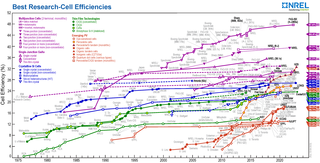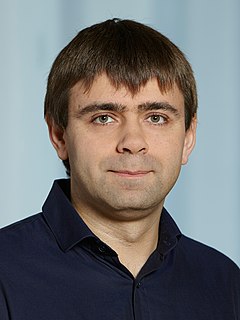Related Research Articles

Photoluminescence is light emission from any form of matter after the absorption of photons. It is one of many forms of luminescence and is initiated by photoexcitation, hence the prefix photo-. Following excitation, various relaxation processes typically occur in which other photons are re-radiated. Time periods between absorption and emission may vary: ranging from short femtosecond-regime for emission involving free-carrier plasma in inorganic semiconductors up to milliseconds for phosphoresence processes in molecular systems; and under special circumstances delay of emission may even span to minutes or hours.

Quantum dots (QDs) are semiconductor particles a few nanometres in size, having optical and electronic properties that differ from those of larger particles as a result of quantum mechanics. They are a central topic in nanotechnology. When the quantum dots are illuminated by UV light, an electron in the quantum dot can be excited to a state of higher energy. In the case of a semiconducting quantum dot, this process corresponds to the transition of an electron from the valence band to the conductance band. The excited electron can drop back into the valence band releasing its energy as light. This light emission (photoluminescence) is illustrated in the figure on the right. The color of that light depends on the energy difference between the conductance band and the valence band, or the transition between discrete energy states when band structure is no longer a good definition in QDs.
A quantum dot laser is a semiconductor laser that uses quantum dots as the active laser medium in its light emitting region. Due to the tight confinement of charge carriers in quantum dots, they exhibit an electronic structure similar to atoms. Lasers fabricated from such an active media exhibit device performance that is closer to gas lasers, and avoid some of the negative aspects of device performance associated with traditional semiconductor lasers based on bulk or quantum well active media. Improvements in modulation bandwidth, lasing threshold, relative intensity noise, linewidth enhancement factor and temperature insensitivity have all been observed. The quantum dot active region may also be engineered to operate at different wavelengths by varying dot size and composition. This allows quantum dot lasers to be fabricated to operate at wavelengths previously not possible using semiconductor laser technology. One challenge in the further advances with quantum dot lasers is the presence of multicarrier Auger processes which increases the nonradiative rate upon population inversion. Auger processes are intrinsic to the material but, in contrast to bulk semiconductors, they can be engineered to some degree in quantum dots at the cost of reducing the radiative rate. Another obstacle to the specific goal of electrically-pumped quantum dot lasing is the generally weak conductivity of quantum dot films.
Deep-level transient spectroscopy (DLTS) is an experimental tool for studying electrically active defects in semiconductors. DLTS establishes fundamental defect parameters and measures their concentration in the material. Some of the parameters are considered as defect "finger prints" used for their identifications and analysis.

Cadmium selenide is an inorganic compound with the formula CdSe. It is a black to red-black solid that is classified as a II-VI semiconductor of the n-type. Much of the current research on this compound is focused on its nanoparticles.

A quantum dot solar cell (QDSC) is a solar cell design that uses quantum dots as the absorbing photovoltaic material. It attempts to replace bulk materials such as silicon, copper indium gallium selenide (CIGS) or cadmium telluride (CdTe). Quantum dots have bandgaps that are tunable across a wide range of energy levels by changing their size. In bulk materials, the bandgap is fixed by the choice of material(s). This property makes quantum dots attractive for multi-junction solar cells, where a variety of materials are used to improve efficiency by harvesting multiple portions of the solar spectrum.

In solar cell research, carrier multiplication is the phenomenon wherein the absorption of a single photon leads to the excitation of multiple electrons from the valence band to conduction band. In the theory of a conventional solar cell, each photon is only able to excite one electron across the band gap of the semiconductor, and any excess energy in that photon is dissipated as heat. In a material with carrier multiplication, high-energy photons excite on average more than one electron across the band gap, and so in principle the solar cell can produce more useful work.

A quantum dot display is a display device that uses quantum dots (QD), semiconductor nanocrystals which can produce pure monochromatic red, green, and blue light.
Photoelectrochemical processes are processes in photoelectrochemistry; they usually involve transforming light into other forms of energy. These processes apply to photochemistry, optically pumped lasers, sensitized solar cells, luminescence, and photochromism.
Philippe Guyot-Sionnest is a professor at the University of Chicago appointed jointly in the departments of physics and chemistry. He works in the field of colloidal semiconductors and metal nanocrystals.

Nanocrystal solar cells are solar cells based on a substrate with a coating of nanocrystals. The nanocrystals are typically based on silicon, CdTe or CIGS and the substrates are generally silicon or various organic conductors. Quantum dot solar cells are a variant of this approach, but take advantage of quantum mechanical effects to extract further performance. Dye-sensitized solar cells are another related approach, but in this case the nano-structuring is part of the substrate.

Photon upconversion (UC) is a process in which the sequential absorption of two or more photons leads to the emission of light at shorter wavelength than the excitation wavelength. It is an anti-Stokes type emission. An example is the conversion of infrared light to visible light. Upconversion can take place in both organic and inorganic materials, through a number of different mechanisms. Organic molecules that can achieve photon upconversion through triplet-triplet annihilation are typically polycyclic aromatic hydrocarbons (PAHs). Inorganic materials capable of photon upconversion often contain ions of d-block or f-block elements. Examples of these ions are Ln3+, Ti2+, Ni2+, Mo3+, Re4+, Os4+, and so on.

Core–shell semiconducting nanocrystals (CSSNCs) are a class of materials which have properties intermediate between those of small, individual molecules and those of bulk, crystalline semiconductors. They are unique because of their easily modular properties, which are a result of their size. These nanocrystals are composed of a quantum dot semiconducting core material and a shell of a distinct semiconducting material. The core and the shell are typically composed of type II–VI, IV–VI, and III–V semiconductors, with configurations such as CdS/ZnS, CdSe/ZnS, CdSe/CdS, and InAs/CdSe Organically passivated quantum dots have low fluorescence quantum yield due to surface related trap states. CSSNCs address this problem because the shell increases quantum yield by passivating the surface trap states. In addition, the shell provides protection against environmental changes, photo-oxidative degradation, and provides another route for modularity. Precise control of the size, shape, and composition of both the core and the shell enable the emission wavelength to be tuned over a wider range of wavelengths than with either individual semiconductor. These materials have found applications in biological systems and optics.
Blinking colloidal nanocrystals is a phenomenon observed during studies of single colloidal nanocrystals that show that they randomly turn their photoluminescence on and off even under continuous light illumination. This has also been described as luminescence intermittency. Similar behavior has been observed in crystals made of other materials. For example, porous silicon also exhibits this affect.
Quantum dots (QDs) are semiconductor nanoparticles with a size less than 10 nm. They exhibited size-dependent properties especially in the optical absorption and the photoluminescence (PL). Typically, the fluorescence emission peak of the QDs can be tuned by changing their diameters. So far, QDs were consisted of different group elements such as CdTe, CdSe, CdS in the II-VI category, InP or InAs in the III-V category, CuInS2 or AgInS2 in the I–III–VI2 category, and PbSe/PbS in the IV-VI category. These QDs are promising candidates as fluorescent labels in various biological applications such as bioimaging, biosensing and drug delivery.
Moungi Gabriel Bawendi is an American chemist of French and Tunisian descent. Born in Paris in 1961 to Hélène Baouendi and Mohammed Salah Baouendi. He is the Lester Wolfe Professor at the Massachusetts Institute of Technology. Bawendi is one of the original participants in the field of colloidal quantum dot research, and among the most cited chemists of the last decade. He became a Clarivate Citation Laureate in 2020. He received his A.B. in 1982 from Harvard University and his Ph.D. in Chemistry in 1988 from the University of Chicago working with Karl F. Freed and Takeshi Oka. It is said that in high school he joined the soccer team for one purpose only...
Light-emitting diodes (LEDs) produce light by the recombination of electrons and electron holes in a semiconductor, a process called "electroluminescence". The wavelength of the light produced depends on the energy band gap of the semiconductors used. Since these materials have a high index of refraction, design features of the devices such as special optical coatings and die shape are required to efficiently emit light. A LED is a long-lived light source, but certain mechanisms can cause slow loss of efficiency of the device or sudden failure. The wavelength of the light emitted is a function of the band gap of the semiconductor material used; materials such as gallium arsenide, and others, with various trace doping elements, are used to produce different colors of light. Another type of LED uses a quantum dot which can have its properties and wavelength adjusted by its size. Light-emitting diodes are widely used in indicator and display functions, and white LEDs are displacing other technologies for general illumination purposes.

Maksym V. Kovalenko is a full professor of inorganic chemistry and the head of the Functional Inorganic Materials group at ETH Zurich. A part of the research activities of the group are conducted at Empa (Dübendorf). He is working in the fields of solid-state chemistry, quantum dots and other nanomaterials, surface chemistry, self-assembly, optical spectroscopy, optoelectronics and energy storage.

Perovskite nanocrystals are a class of semiconductor nanocrystals, which exhibit unique characteristics that separate them from traditional quantum dots. Perovskite nanocrystals have an ABX3 composition where A = cesium, methylammonium (MA), or formamidinium (FA); B = lead or tin; and X = chloride, bromide, or iodide.
Uri Banin is an Israeli chemist and a professor at the Hebrew University of Jerusalem, currently holding the Alfred & Erica Larisch Memorial Chair at the Institute of Chemistry. He is recognized as one of the pioneers of nanoscience in Israel.
References
- 1 2 Stefani, Fernando D, Jacob P Hoogenboom, and Eli Barkai. 2009. "Beyond quantum jumps: Blinking nano - scale light emitters." Physics Today 34-39.
- 1 2 3 Frantsuzov, Pavel; Kuno, Masaru; Jankó, Boldizsár; Marcus, Rudolph A. (2008). "Universal emission intermittency in quantum dots, nanorods and nanowires". Nature Physics. 4 (7): 519–522. arXiv: 0810.2509 . doi:10.1038/nphys1001. S2CID 18751911.
- ↑ Krauss, Todd D.; Peterson, Jeffrey J. (2010). "Bright Future for Fluorescence Blinking in Semiconductor Nanocrystals". J. Phys. Chem. Lett. 1 (9): 1377–1382. doi:10.1021/jz100321z.
- ↑ Cordones, Amy A.; Leone, Stephen R. (2013-03-25). "Mechanisms for charge trapping in single semiconductor nanocrystals probed by fluorescence blinking". Chemical Society Reviews. 42 (8): 3209–3221. doi:10.1039/C2CS35452G. ISSN 1460-4744. PMID 23306775.